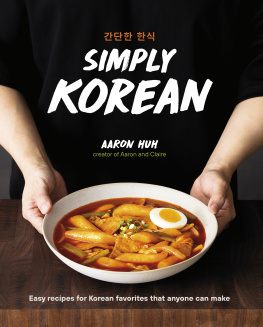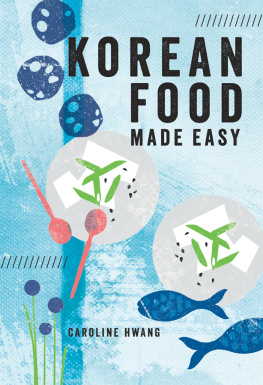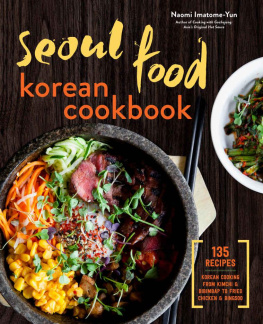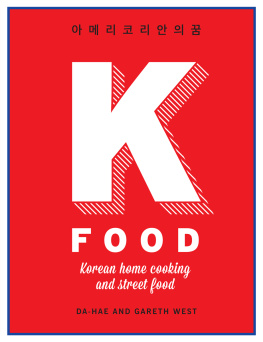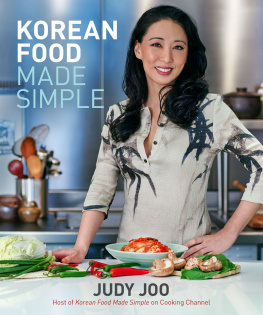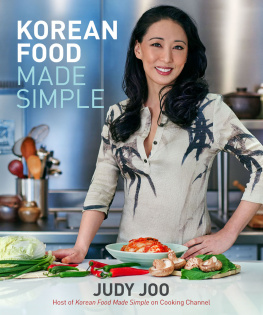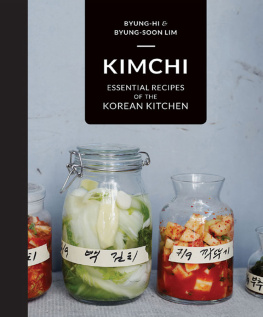Contents
Guide
JUDY JOO'S
KOREAN SOUL FOOD
with Mi Kyung Jeong
Photography by
Yuki Sugiura

Introduction
I am a French-trained, Korean American Londoner; my recipes deeply reflect my multicultural upbringing and life. I consider myself a true global citizen, embracing various cultures and traditions.
I am the daughter of Korean immigrant parents, and am proudly dedicating this book to my father for his 80th birthday.
My father was born in Chongju, a small coastal village between Sinuiju and Pyongyang, in what is now North Korea. In 1945, the communists invaded, and seized his fathers land, forcing them to pack up what they could carry, and flee south with his eight siblings. Even at just six years old, my dad had to haul his share a small backpack full of fine silk to be used to barter their way onto trains heading south and to buy safe passage through Russian-occupied territory. They took a train to Haeju, then crossed the southern border. They escaped under the cover of darkness, wading through the seas low tide to Kaesong, which was then part of South Korea. In 1950, the Korean War broke out and my dads family fled further and sought refuge on Jeju island. My father was too young to be drafted, but four of his older brothers were enlisted. My dad grew up in a refugee camp on this small volcanic island, which is now ironically a popular holiday destination. He remembers looking up at tall, smartly-clad US soldiers and begging them for 'bon bons'.
From this challenging situation, he somehow managed through hard work to make it to the 'Harvard' of Korea and attended Seoul National University Medical School. From there he immigrated to the USA in 1967 for his internship and residency in Psychiatry in New York City.
He was introduced to my mom, whose older brother was my dads classmate. She had travelled to the US alone (unheard of in those days) to get her masters degree in Chemistry at Ohio University. They got married in 1970, and are still together. My sister, Sonya, came along a few years later, and then they moved to New Jersey, where I was born.
My mom had to make everything from scratch to get that taste of home they so desperately craved. Our porch was crowded with pots teeming full of fermenting delicacies. Our garage boasted hangers of drying seaweed and our picnic table often showcased chillies basking in the sun. A small garden at the end of our yard produced a bounty of perilla leaves, chillies and Korean squash. And, every now and then, large packages from Korea would arrive, stuffed full of coveted culinary treasures, such as dried seaweed, anchovies and persimmons.
I grew up eating glorious home cooking made with the love of my mothers hands and heart. I often watched my mom make huge vats of kimchi, and my sister and I were regularly enslaved to make hundreds of dumplings at a time. I remember her scooping up a small bite of whatever she was making and feeding us directly from her fingers. Food was, and still is, a language of love for her, and it has become one of mine too.
I learned so much from my mom, and through my travels, and my time in the USA, Korea and the UK, I have embraced various cooking techniques and ingredients, many of which youll see reflected in this book. I hope my recipes feed your soul, satiate your tummy, and make you and your loved ones smile.
Korean Storecupboard
1 Dashima (dried kelp)
These dried flat sheets of seaweed are used with dried anchovies and mushrooms to make a traditional Korean stock. Also known as kombu, this kelp is full of umami flavour and adds great depth and complexity.
2 Pyogo Beoseot (dried shiitake mushrooms)
I always add these richly flavoured mushrooms to my Korean stock to boost flavour even more, especially when making a vegetarian version.
3 Gochujang (Korean chilli paste)
This fermented chilli paste is one of the cornerstones of Korean cooking, and there really is no substitute. Bright, fiery red in colour, but not overly spicy, this thick unctuous paste is used in various ways. It is made with gochugaru (Korean chilli paste), dried fermented soy bean powder, salt, sweet glutinous rice powder and usually a sweetener (honey or sugar). Recipes can vary depending on region, but it is always fermented and the resultant flavour is richly deep and distinctive.
4 Mirin or Mirim (Korean cooking wine)
Sweet and light with a low alcohol content, mirin adds a hint of nectarous flavour to many dishes.
5 Gyeoja (Korean mustard)
Similar to English mustard, gyeoja is bright yellow and hot and spicy. Available in both in powder and paste form, it is used in dressings and as a side condiment.
6 Daechu (dried jujube dates)
Dried jujubes boast an eye-catching shiny, dark-red skin, and a balanced, moderately sweet taste. Also called Chinese dates, these dried fruits are used in both savoury and sweet cooking. You can now buy them dehydrated and sliced, which makes for great snacking and garnish.
7 Yujacha (citron tea syrup)
This citron fruit and honey syrup resembles marmalade, but is much more fragrant and luxurious in flavour. Yuja fruit, or yuzu in Japanese, tastes like the offspring of a bergamot lemon and a satsuma mandarin. It is traditionally used to make tea, but I use it for a number of different dishes.
8 Dwengjang (Korean soy bean paste)
Deeply flavoured and dark brown, this rich, fermented, pungent paste is stronger and coarser than its Japanese counterpart, miso. Red miso can be used as a substitute, but dwengjang does have its own unique taste that makes it worth stocking.
9 Myulchi (dried anchovies)
These little fish come in a myriad of different sizes and are used in various ways. This larger variety is used primarily for infusing flavour into broths. My mom always removed the heads and the guts to prevent bitter undertones.
10 Kkae (black and white sesame seeds)
Sesame seeds are used liberally in Korean cooking. White ones are more common and can be bought pre-roasted in large shaker jars. I also like to buy kkaesogeum (sesame seed salt), which is a mix of half crushed roasted seeds with salt, perfect for seasoning everything from banchan side dishes to barbecue.
11 Saewoojeot (salted shrimp)
These tiny, heavily salted shrimp are an essential ingredient for making kimchi, but are also used to make banchan (side dishes) and in soups and stews.
12 Ganjang (soy sauce)
Soy sauce is a by-product of making dwengjang, and can be fermented for years, developing in taste and complexity much like an aged balsamic vinegar. There are many types, with the darker varieties being used for heartier fare and soups and stews, and the lighter versions for more delicate dishes. Use soy sauce to add seasoning and flavour, but it does not always replace the need for salt entirely.
13 Chamgireum (sesame oil)


